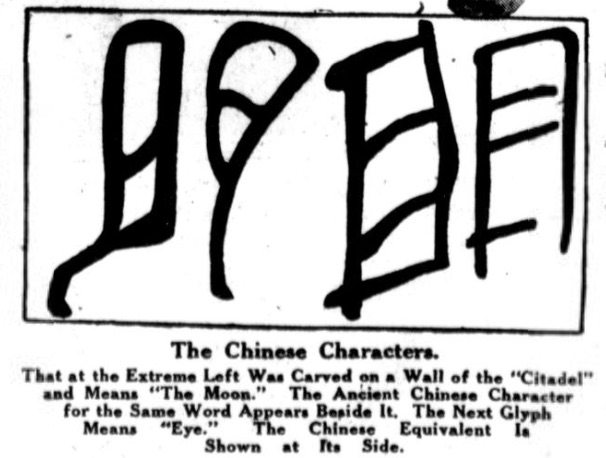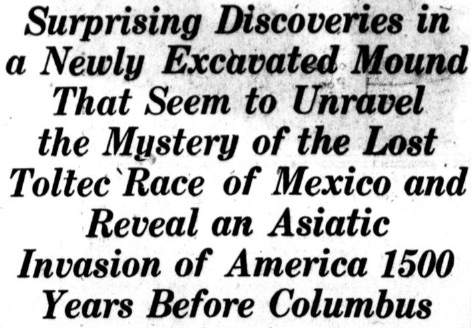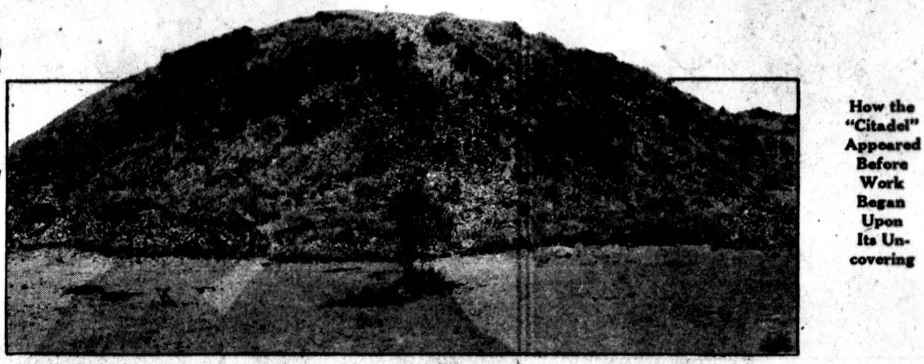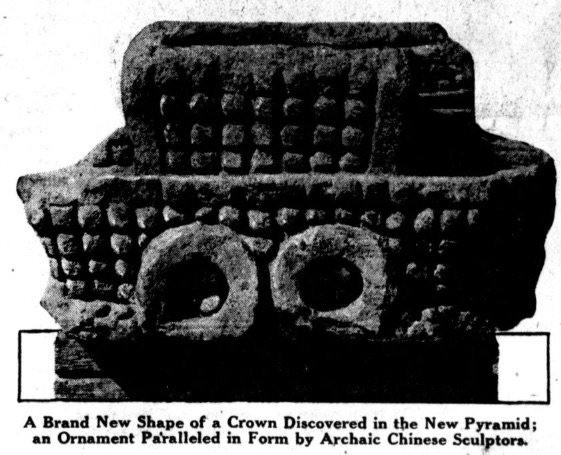
Did the Chinese influence the Aztec people and are there Chinese characters on the pyramids discovered in Mexico? This is a debate that has been going on since the 1920s, from which the article below is from.
Prehistoric Mexican Pyramid Built By Chinese

By the recent discovery of certain unmistakable and easily translatable Chinese characters carved upon the walls of a Toltec pyramid in Teotihuacan, an ancient, long buried city in the valley of Mexico, new and astonishing light has been thrown upon one of the great mysteries of the world.
It has long been known that the extraordinary civilization which arose in Central America perhaps as far back as 30,000 years ago, had its origin in a race of pyramid builders called the Mayans. Something happened to this people so that perhaps 3,000 years ago their numbers were enormously lessened and their strength decreased. About 1,500 years ago began another civilization called the aztec, with which most readers are familiar.
But between the Mayan ascendency and that of the Aztecs there is scanty evidence of the existence of a lost race named the Toltecs, and these have long held a doubtful position in the mind of science. It was clear from the traditions of both Aztecs and Mayans that the Toltecs did not belong to either of them. Yet except their enormous crumpling pyramids and great jungle buried cities so little evidence remained of what they actually had been that for a long time scientists believed that instead of having been lost they had had no real existence and that the word Toltec simply meant “builder” and had been applied to certain ancient forefathers of the Mayans by descendants – much in the same way as “patriarchs” are referred to today.
The destructions of practically all the written records both of Mayans and Aztecs by the fanatical Spanish at the time of the conquest of Mexico wiped out this source of information. Centuries of oppression have caused all except a fragments of the legendary history of this American civilization to be lost from the memories of the conquered races.

The recent discoveries at Teotihuacan – not only of the amazing characters, but of other inscriptions, pottery and ornamentation – would seem to indicate that at least 2,000 years ago there was an invasion of asiatics, either Chinese or Mongols, who found foothold on the west coast of Mexico. These were the Toltecs. The adventurers came sailing in their junks along, without doubt, the chain of southern Pacific islands. They started, probably, from Malaysia or Java. In their course eastward they provisioned themselves and secured water at the island stepping across the Pacific. The last lap of the journey to the western shores of Central America was, however, a prodigious one, far more dangerous and longer than that of Columbus fifteen hundred years later.
This little community, landing, managed to exist and to gather to itself other elements of strength from surrounding tribes. It is possible that when they landed the great catastrophe – famine or pestilence, whatever it was – had just worked its will with the Mayan peoples and so no opposition was encountered by them. At the same time, the Aztec civilization had not yet become powerful enough to resist them.
At any rate the invaders thrived. At least they managed to conquer and to hold about 800 square miles of the Mexican valley. They took the architecture and the arts of the Mayans and developed them with certain Asiatic trimmings. And in their great cities they lived, surrounded always by more or less inimical Aztecs and the remnants of the old Mayans, who it is clear, never ceased to look upon them as invaders.
Whether the Toltecs also were destroyed by pestilence and famine or were finally overwhelmed by the hostile civilization surrounding them is not known. In the absence of records referred to it can probably never be known from Aztec or Mayan sources.
But it is the hope, as well as the belief, of the excavators of Teotihuacan that they will find records by these Asiatics which will not only make clear their own origin and fate but also solve the equally great mysteries of the history of those into whose lives they thrust themselves.
The Chinese symbols found and identified up to date are those for “sun” and “moon” and “eye.” Ideographs signifying “turn to right” and “turn to left” have also been deciphered. All these characters have been absolutely identified by the Honorable F. K. Fong, Chinese Charge d’Affaires in Mexico, who says:
“I can emphatically state that the character of certain signs and figures which have been found upon the walls of the new pyramid is Oriental. The special signs for ‘sun,’ ‘moon,’ ‘eye’ and those indicating motion from left to right, and from right to left, are paralleled in an astonishing exactness in an old Chinese manuscript which I possess, and which is now in the hands of Louis Cabrera, Secretary of Hacienda, in Mexico, for study by the Archaeological Department of the government. They can ve read with ease by any one familiar with the ancient script of my country. It is, in my opinion, entirely futile to dispute the Oriental character of the pottery and carvings that have been unearthed at Teotihuacan. Some might well be Mongolic or even from certain regions of India, but beyond any doubt they belong to Asiatic races.”
The origin of the remarkable American civilizations which were destroyed by the Spanish has long been something about which science has held two strongly contrasting views. Up until only recently those who stood out on the theory that they were developments of a native American race were few indeed. But within the past decade so much evidence has been brought to light that now the show is on the other foot.
That certain tribes of North American Indians are of ancient Mongolian origin is, of course, conceded. These, without question, made their way from Asia over the Bering Straits. Perhaps there was a land bridge which contacted what is now Alaska with Siberia.
But the southern races, such as the Mayans, the Aztecs, the Incas of South America, and their associated tribes, present a problem which cannot be explained by any immigration from the far north. In the first place they would have left traces of their occupation on their way to the south. There are no such traces. Furthermore, the civilization of South America was absolutely different from that of the north. Those who held to the theory of origination in Asia were forced, therefore, to assume that the early Americans passed over by way of the Pacific land bridge which hundreds of thousands of years ago existed between Asia and America or by way of boats across the ocean. On the other hand, they could not explain certain absolutely un-Asian characteristics in architecture and ornamentation in the buildings. Conversely, those who held for an indigenous origin were confounded, as in the case of the Toltecs, by distinctly Asian characteristics upon houses and temples.

The new discoveries reconcile these differences and make plain how they occurred.
Particularly has the pyramid – long held to be a purely Egyptian structure – which is found in such quantities throughout Central American, a mystery indeed. Those who believed the ancient American culture to be Asian pointed to them as proof that those who settled America brought the idea with them from the East. Those who held the opposite view contended that the pyramid from was also indigenous to America and had spread from America to Asia.
It is interesting to note that evidence is steadily accumulating that the latter view is correct. It will also be surprising to many to know that there are pyramids in Mexico which are much larger than those of Egypt. At ancient Cholula, near Pueblo, a pyramid remains which covers twice the area of the famous pyramid of Cheops on the Nile, and exceeds the latter also in bulk, although it is not so high, since the American pyramids were built simply as foundations for temples.
It is the growing belief of science now that a human race arose in American during the Pleistocene Age, a hundred thousand years go – certainly fifty thousand. They developed independently of the Asian stock. It is, of course, also possible that both arose from a vanished continent in the Pacific from which they spread both east and west. Those who believe that the American race was indigenous hold what is called the theory of the multiple origin of man – that is, that man evolved not in one place alone but in several parts of the world’s surface. Some of the greatest scientific minds are holders of this doctrine.
According to them, the Mayan civilization as well as the Peruvian, were developments from this Pleistocene people of the Americas. Le Plongeon, the famous French archaeologist, believed that the Egyptian migrated from what is now Yucatan about twenty thousand years ago.
After disaster came to the Mayan civilization there followed, as has been said, the Asian invasion of those called the Toltecs. Teotihuacan was the ancient capital of this people. Its antiquity is emphasized by the fact that what is now Mexico City and what was then the Aztec Tenochtitlan was founded about 1325 A.D., and that to the Aztecs even this Teotihuacan was known as the dead city.
When the present investigators, who are working under the direction of the Mexican Bureau of Agriculture, began work on the old capital every trace of building was covered by earth and trees. The great pyramids and temples were brush covered hills with nothing about them to indicate human origin.
Soon two of the greatest pyramids in the world were cleared – that of the Sun and that of the Moon. The pyramid of the Sun rises 216 feet from the plain from a base of half a million square feet; that of the Moon is smaller and is 151 feet high.
The “Citadel” pyramid, upon which the inscriptions were found, occupies the highest part of the great plain on which arose the lost city. From the eminence on which it rests comes its name, for it is not really known whether this place was or was not the actual citadel of ancient Teotihuacan. One of the photographs on this page shows it as it was before the excavators began their work upon it. The entire plain is dotted with similar hills, all of which will in time be uncovered. It is not at all unreasonable to predict that in this buried place will be unearthed sculptures and perhaps manuscripts upon skins – such as not only Toltecs but Mayans and Aztecs wrote – which will give Americans some real light upon the antiquity and history of their world.
Dr. Clark Wissler, author of “The American Indian,” Curator of Anthropology of the American Museum of Natural History, New York, and recently elected chairman of the National Research Council, Washington, after examining these illustrations, said:

“Assuming the genuineness of the inscriptions found in the citadel of the pyramid of Teotihuacan, we have merely evidence of a rather late Asiatic invasion, thousands of years after settlements in Mexico. Prior to that, and later also, were successive invasions by peoples who came from we do not yet know where.
“Before any of these invasions we have the evidence of the existence of a Pleistocene race, which has so divided and upset the paleontologists of America.
“The Oriental inscriptions of the new find, however, are most interesting and should greatly aid in clearing up the vexed problems of some Mexican races and their origins. I must repeat, however, that I asserted in my work, ‘The American Indian,’ which contained a summary of all that has been discovered concerning past and present races of the new world, that there is no evidence that primitive Americans were derivatives from Asiatic stock, or that the Asiatics were derived from American stock.
“The best we can do at present is to conceive a common ancestor somewhere and let it go at that. That theory is applied to the varied races of mankind of the old world. Why not apply it to America?”
The Toltecs took their name from “Tollan,” one of the largest of their cities. Archaeology has traced something of their story from the eighth to the eleventh centuries, but we did not know for how many centuries their development had proceeded, or from where they came and what was their origin, until the discovery of the Chinese writing in the pyramid at Teotihuacan.
The early history of this dead race must have been as dramatic as that of the first colonists to the Atlantic coast from Europe.
Coming from Asia, as discoveries prove they did, they lived here thousands of miles from their own people, bringing with them their culture. Gradually they gained a foothold on the verge of a continent, whose vastness they could not have conceived, surrounded perhaps by tribes from whom they had to protect themselves and who they captured to use as their slaves. Becoming assured of their situation they grafted their own arts upon those of the conquered, built, through the centuries, their great pyramids crowned with temples, their forts and cities and monuments to their dead kings and priests.
Doubtless the time came when they forgot their ancient origin and considered that they sprang from the plain on which they had raised their cities.
Then gradually through the centuries they began to decline in strength and in power.
Those who had always menaced at last swept over them like a tornado; wiped them out!
The Aztecs destroyed their cities and enslaved their people, reigning triumphant in their stead, until men in armor and with white skins came upon them from the sea and swept them out of existence in their turn.
And now, hundreds of years later, we are beginning to read their tragic story from out of the depths of the bush-covered mounds and from the characters in an ancient language written on their walls.
And what may science not learn when all that lost city is uncovered?
Source: The Washington times. (Washington [D.C.]), 18 April 1920.

